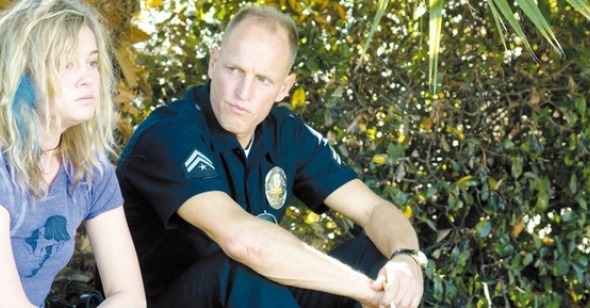Police State
By Benjamin Mercer
Rampart
Dir. Oren Moverman, U.S., Millennium Entertainment
The title of Oren Moverman’s bleary-eyed sophomore feature, Rampart, refers to a division of the LAPD embroiled in a corruption scandal, but also to the battlement of self-justification that the film’s protagonist, Dave Brown (Woody Harrelson), has erected against the world. Brown—given the moniker “Date Rape” by his officer colleagues for his decade-ago vigilante killing of an alleged rapist (the rare subject on which he’s coy)—spends the majority of the movie verbosely claiming, with his head tilted back in smug certitude, the airtight defensibility of his actions in any arena, professional or domestic, in which he’s called upon to account for himself.
And in this cop drama, there is, naturally, a lot to account for. Moverman’s film, cowritten by crime novelist James Ellroy, is set in 1999, as the review-panel aftershocks of Rampart begin to convulse the department. Brown’s not directly implicated in the scandal, but he’s emblematic of the ingrained culture of corruption and brutality brought to light by it; he also grows increasingly paranoid about becoming a strategic sacrifice to the press in the midst of the investigation. The bullheaded Vietnam vet, a drive-time listener to conservative talk radio, still operates as a member of his father’s LAPD (Brown routinely meets with one of his late dad’s colleagues, played by Ned Beatty, for hushed conversations in shades-drawn diners), even as that institution effectively ceases to exist. “You’re a dinosaur, Date Rape,” snipes his eldest daughter at one point.
Rampart starts off as a bracingly immediate, handheld record of a traditional day on the beat: We see Brown intimidate a female junior officer (Stella Schnabel, in what is, surprisingly, this star-studded movie’s showiest bit of casting) into eating french fries she doesn’t want, employ coercive interrogation tactics to learn the location of a meth lab, and take a nightstick to another man in broad daylight. Caught on tape, this makes for prime local news. Brown attempts to take refuge at home—right next door to his two daughters (Brie Larson, Sammy Boyarsky) and two ex-wives (Anne Heche, Cynthia Nixon), in a compound-like arrangement—but faces increasing hostility there as well. Later, he digs himself in deeper after an in-uniform rip-off of a high-stakes card game doesn’t go as planned. Following this sequence are some of the film’s finest scenes, pairing Harrelson with Ben Foster (the former’s costar in Moverman’s debut as a director, The Messenger) as a beady-eyed, wheelchair-bound homeless man who may have witnessed the botched stickup, and whose apparent head injury serves as a sort of correlative to Brown’s self-delusion.
Moverman seems less interested in the particulars of the misconduct than in conducting an experiment in perspective. He places the audience inside the head of his protagonist (in this sense, the film is not entirely dissimilar from Jeff Nichols’s Take Shelter, though that film’s main character was typically masculine; Dave Brown is, in the tradition of Bad Lieutenant, almost baroquely so). As such, each trick in Moverman’s stylistic arsenal seems designed to induce a sense of disorientation, occasionally—as in a late club scene in which strobes pulse, bass thumps, and Brown gorges on a burrito that he’s then unable to hold down—to the point of nausea. Some of the camera placements (by DP Bobby Bukowski), particularly in the barroom where Brown flirts with a defense attorney played by Robin Wright, suggest a coordinated eavesdrop, smartly signaling the protagonist’s mounting suspicions. During one closed-door meeting in which Brown holds his own against an LAPD lawyer (Sigourney Weaver) and the DA (Steve Buscemi, briefly), the camera moves in overlapping rotations, creating an effect somewhere between stroboscope and surveillance video. Throughout, the predominant visual note, especially as Brown begins to more heavily self-medicate, is the sun-scorched glare of a rude awakening. Moverman’s grab-bag approach to these techniques can be disorienting in itself, but it also articulates the position of a police officer who, the ground shifting beneath his feet, must constantly readjust his tactics of self-preservation. The general seventies burnout vibe also nicely evokes the era that incubated Brown’s idea of acceptable on-the-job comportment. (At one point we see the officer’s idea of adapting to the times: he declares to an internal affairs officer played by Ice Cube that he’s no racist, but rather hates “all people, equally.”)
The director’s tinkering presence is palpable throughout, but Harrelson owns this movie, as he needs to, reeling through Brown’s grandstand distortions of the truth with just the right balance of performative relish and unhinged menace. At home, Brown appears a good deal more impotent to resistance, a shift nicely modulated by the actor. His voice is least prominent at the dinner table, where the Altman-derived overlapping dialogue ramps up. Early on, Brown drifts into the dining room, martini glass in hand, and unsuccessfully propositions both of his ex-wives. He then confronts his daughter Helen about a provocative feminist collage she’s made—“What’s it mean?”—before drifting back out of the room, without having eaten a thing.
Rampart—which peters out into a dissipated haze, failing to offer much in the way of resolution—has inspired some to ask variations on that same question, “What’s it mean?” Others have deemed the film a rather lean scrap of best-actor Oscar bait, perhaps the most extreme reaction coming from Jonathan Rosenbaum, who suggested, in a blurb for Vulture’s worst-of-2011 poll, that “liberal activist” Harrelson’s “racist thug” role was little more than a politically calculated type of dress-down that dupes the Academy year in and year out. For sure, the film is hampered to some degree by its stylistic brazenness, but to ask for a more well-rounded or politically nuanced film is to wish away jagged edges that are there very much by design. Moverman makes felt, without being overly didactic, both the private hell and public cost of authority run amok, and the reflexive blame deflection that follows—diagnosing, in effect, the psychosis that has gripped American political life since the turn of the new century.
